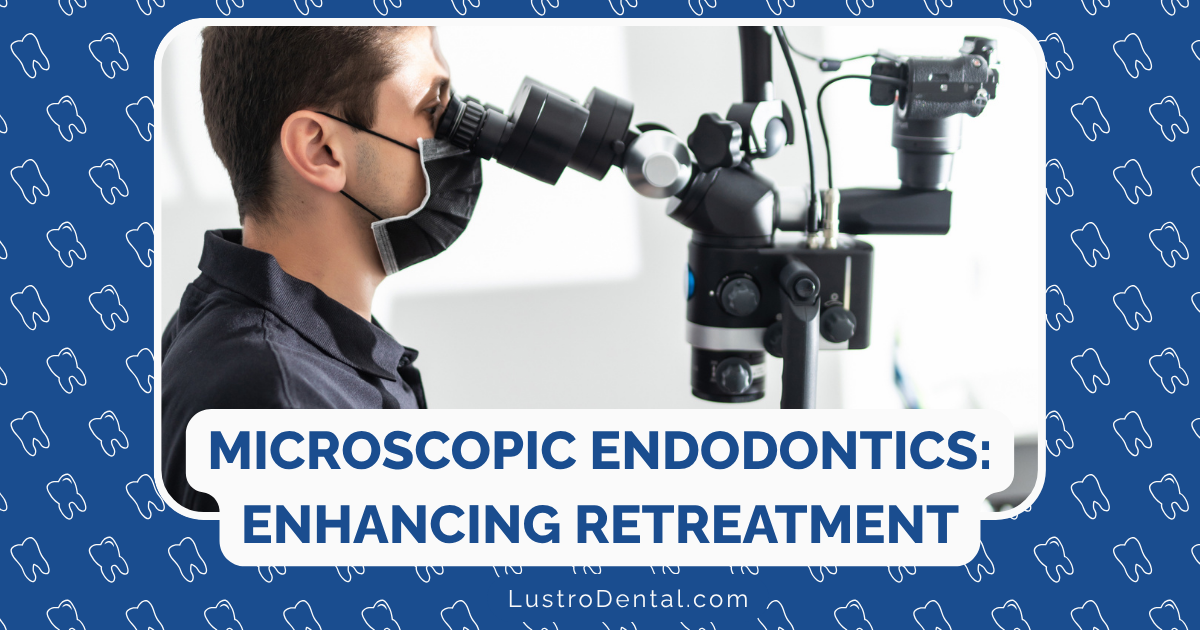Microscopic Endodontics: How Magnification Improves Retreatment Success

When a root canal treatment fails, the decision to pursue retreatment often comes with questions about the likelihood of success. After all, if the initial treatment didn’t resolve the problem, what guarantee is there that a second attempt will yield better results? The answer often lies in advanced technology that wasn’t necessarily available or utilized during the first procedure—specifically, the dental operating microscope (DOM).
Microscopic endodontics represents one of the most significant advancements in modern endodontic practice, transforming what was once considered an art reliant on tactile sensation into a precise, visually-guided science. This evolution has been particularly impactful in retreatment cases, where success depends on identifying and addressing factors that contributed to the initial failure.
The Evolution of Visualization in Endodontics
Endodontic treatment has always been challenging due to the microscopic nature of root canal systems and their limited accessibility. For decades, endodontists relied primarily on:
- Tactile sensation: Feeling their way through canals with hand instruments
- Mental mapping: Creating a three-dimensional mental image based on radiographs and knowledge of dental anatomy
- Indirect visualization: Using radiographs to confirm positions and assess outcomes
The introduction of magnification has dramatically changed this approach. According to a study published in the Journal of Dentistry, the use of microscopes in endodontic practice has increased from 52% in 1999 to over 90% in recent years. This shift represents more than just adopting new technology—it’s a fundamental change in how endodontic procedures are performed.
Understanding the Dental Operating Microscope
The dental operating microscope provides magnification ranging from 4× to 25× or higher, coupled with coaxial illumination that eliminates shadows in the operating field. Modern microscopes also feature:
- Variable magnification: Allowing practitioners to adjust magnification levels based on the specific task
- Integrated light sources: Providing shadow-free illumination directly into the operating field
- Documentation capabilities: Many systems include cameras for capturing images and videos
- Ergonomic design: Supporting proper posture during lengthy procedures
Dr. Sarah Johnson, endodontist at Global Surgical, explains: “The microscope transforms what we can see and, consequently, what we can treat. Details that were previously invisible become clearly apparent, allowing for more precise and comprehensive treatment.”
Why Retreatment Cases Particularly Benefit from Magnification
Retreatment cases present unique challenges that make microscopic visualization especially valuable:
1. Identifying the Cause of Initial Failure
Before effective retreatment can be performed, the endodontist must determine why the initial treatment failed. Common causes include:
- Missed canals: Additional canals that weren’t identified and treated
- Incomplete cleaning: Areas of the canal system that weren’t adequately disinfected
- Inadequate obturation: Spaces in the filling material that allowed bacterial recolonization
- Procedural errors: Perforations, ledges, or other complications during the initial treatment
The microscope allows for detailed examination of the pulp chamber floor and canal orifices, revealing subtle clues that might be invisible to the naked eye.
2. Navigating Complex Anatomy
Root canal systems can be incredibly complex, with lateral canals, isthmuses, and anatomical variations that are difficult to detect without magnification. A 2022 study found that 40 root canal orifices were not detected with the naked eye, but 33 were successfully located using the DOM—an 82.5% success rate for identifying missed canals.
Dr. Michael Chen, researcher in endodontic microsurgery, notes: “The microscope doesn’t just make things bigger; it reveals an entirely new level of anatomical detail that changes our understanding of what we’re treating.”
3. Addressing Technical Challenges
Retreatment often involves technically demanding procedures such as:
- Removing existing filling materials: Gutta-percha, sealers, and other materials must be completely removed
- Retrieving separated instruments: Broken file fragments must be visualized and safely removed
- Managing perforations: Iatrogenic perforations need to be precisely identified and repaired
- Negotiating calcified canals: Narrowed canals require careful location and instrumentation
Each of these challenges becomes significantly more manageable with microscopic visualization.
Specific Benefits of Microscopes in Endodontic Retreatment
1. Enhanced Detection of Missed Canals
Missed canals are a leading cause of endodontic failure. The maxillary first molar, for example, often has a second mesiobuccal canal (MB2) that can be difficult to locate. Studies have shown:
- The MB2 canal is present in 55-70% of maxillary first molars
- When the initial treatment is performed without a microscope, the odds of developing a periapical lesion in the MB root are 3.1 times higher
- The presence of a missed MB2 canal is significantly associated with the presence of periapical lesions (odds ratio = 5.1)
According to research published in the Journal of Endodontics, teeth treated without microscopes were significantly more likely to have missed canals requiring retreatment.
2. Improved Instrument Retrieval
Separated instruments present a significant challenge in retreatment cases. The microscope provides several advantages:
- Precise visualization of the fragment’s position and orientation
- Better control of ultrasonic instruments used for retrieval
- Reduced risk of additional damage to the canal walls
- Higher success rates for removal
A clinical study reported in PMC found a 72.3% success rate for removing separated instruments using the microscope combined with ultrasonic techniques.
3. More Effective Removal of Previous Filling Materials
Complete removal of existing filling materials is essential for retreatment success. Microscopic visualization allows the endodontist to:
- Identify remnants of filling materials that might be missed otherwise
- Ensure thorough cleaning of canal walls
- Detect and address areas of reinfection
- Minimize unnecessary removal of healthy tooth structure
4. Precise Management of Perforations
Perforations—whether from the initial treatment or created during retreatment—require accurate diagnosis and precise repair. The microscope enables:
- Exact localization of the perforation
- Assessment of size and nature of the defect
- Precise placement of repair materials (such as MTA)
- Verification of the quality of the repair
The previously mentioned study reported a success rate of 72.7% for managing canal perforations using the DOM, with even higher rates (81.3%) for coronal perforations.
5. Negotiation of Calcified Canals
Calcified canals that couldn’t be negotiated during the initial treatment become more manageable with microscopic assistance:
- The canal opening, even if minimal, can often be visualized
- Ultrasonic instruments can be precisely directed
- Progress can be visually monitored to avoid procedural errors
- Success rates for negotiating calcified canals reach 74.0% with microscopic techniques
Impact on Retreatment Success Rates
The evidence for improved outcomes with microscopic endodontics is compelling:
Nonsurgical Retreatment
A 2025 study in the Journal of Dentistry found that microscope-assisted root canal treatment resulted in:
- 2.9-fold increase in positive outcomes based on strict criteria
- 3.2-fold increase based on loose criteria
- Particularly significant improvements for posterior teeth
Overall success rates for endodontic retreatment range from 80-88% according to Endodontic Practice US, with microscope use being a key factor in achieving the higher end of this range.
Surgical Retreatment (Endodontic Microsurgery)
The impact of microscopes on surgical endodontics has been even more dramatic:
- Traditional surgical techniques show success rates of approximately 59%
- Microsurgical techniques demonstrate success rates exceeding 90%
- According to a 2024 study in Nature, apical microsurgery has a success rate of more than 90%
A systematic review published in the International Endodontic Journal found that microsurgical techniques had a periapical healing rate of 94% compared to 59% for traditional approaches.
The Technical Aspects of Microscopic Endodontic Retreatment
Optimal Magnification Levels for Different Procedures
Different phases of retreatment benefit from specific magnification levels:
- Low magnification (4-6×): Initial examination, orientation, and access preparation
- Medium magnification (8-12×): Locating canal orifices, removing previous materials, and general instrumentation
- High magnification (16-25×): Managing delicate procedures like instrument retrieval, perforation repair, and examining canal walls
Dr. Lisa Wong, endodontic microsurgery specialist, advises: “Learning to work with the microscope is like learning a new language. You start with basic phrases and gradually become fluent. The key is understanding which magnification level serves each specific task best.”
Ergonomic Considerations
Proper ergonomics is essential for effective microscope use:
- Operator position: Ideally seated upright with neutral spine positioning
- Microscope positioning: Aligned to allow a comfortable working position
- Patient positioning: Adjusted to provide optimal access to the treatment area
- Assistant positioning: Coordinated to maintain visibility and efficient instrument exchange
A 2025 survey found that improved vision (61.7%) and high precision (35%) were cited as the primary advantages of using magnification systems in endodontic treatments.
Integration with Other Technologies
Modern microscopic endodontics often integrates with complementary technologies:
- Cone Beam Computed Tomography (CBCT): Provides three-dimensional information about canal anatomy
- Ultrasonic instruments: Enable precise removal of materials and conservative preparations
- Digital documentation systems: Allow for case documentation and patient education
This integration creates a comprehensive approach to complex retreatment cases.
Challenges and Limitations
Despite its benefits, microscopic endodontics has some challenges:
1. Learning Curve
Mastering the microscope requires time and practice. Many endodontists report:
- Initial awkwardness when transitioning from traditional techniques
- Temporary decrease in efficiency during the learning phase
- Need for specific training and mentorship
2. Cost Considerations
The financial investment can be substantial:
- Quality dental operating microscopes typically cost between 12,500 and 25,000 euros
- Additional expenses for camera systems and other accessories
- Potential need for office modifications to accommodate the equipment
However, according to the 2025 survey, 40% of practitioners reported recouping these costs within 1-2 years.
3. Physical Limitations
Some clinical situations present challenges even with microscopic assistance:
- Patients with limited mouth opening
- Posterior teeth with difficult access angles
- Cases where the root anatomy is extremely complex
The Patient Experience: What to Expect
From the patient perspective, treatment by an endodontist using a microscope may differ in several ways:
Potential Benefits
- More conservative treatment: Preservation of more natural tooth structure
- Higher success rates: Increased likelihood of resolving the problem
- Fewer complications: Reduced risk of procedural errors
- Better documentation: Improved ability to explain findings and treatment
Practical Considerations
- Longer appointments: Microscopic procedures may take more time
- Potentially higher costs: Some practitioners charge additional fees for microscope use
- More specialized referrals: Cases may be directed to endodontists with microscopic expertise
Dr. Robert Wilson, endodontist, shares: “When I explain to patients how the microscope helps me see and treat problems that might otherwise be missed, they understand the value. Many are fascinated by the technology and appreciate the thoroughness it enables.”
The Future of Microscopic Endodontics
As technology continues to advance, several trends are emerging:
1. Integration with Artificial Intelligence
AI systems that can analyze microscopic images in real-time may soon:
- Help identify subtle anatomical features
- Suggest optimal treatment approaches
- Document findings automatically
- Provide decision support during complex procedures
2. Enhanced Visualization Technologies
Beyond traditional microscopes, new visualization tools include:
- Augmented reality systems: Overlaying digital information on the microscopic view
- 3D visualization: Creating depth perception beyond what traditional microscopes offer
- Specialized illumination techniques: Using different light wavelengths to highlight specific tissues
3. Miniaturization and Accessibility
As technology evolves, we can expect:
- More compact and affordable microscope systems
- Easier integration into general dental practices
- Broader adoption across all aspects of dentistry
Conclusion: The Microscopic Advantage in Endodontic Retreatment
The evidence is clear: microscopic endodontics significantly improves retreatment outcomes. By enabling practitioners to see what was previously invisible, the dental operating microscope has transformed endodontic retreatment from an uncertain proposition to a highly predictable procedure with success rates approaching those of initial treatment.
For patients facing the prospect of endodontic retreatment, seeking a provider who utilizes microscopic techniques can make a substantial difference in the likelihood of success. The microscope doesn’t just magnify the operating field—it magnifies the possibilities for saving teeth that might otherwise be lost.
As one endodontist aptly put it: “Treating root canals without a microscope is like trying to thread a needle in the dark. You might succeed through skill and luck, but why not turn on the light?”
Have you experienced endodontic retreatment with microscopic techniques? Share your thoughts in the comments below.







